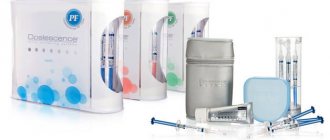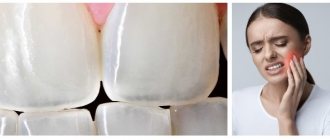Healing properties of tea tree
Tea tree oil is a medicinal substance that is produced from the Melaleuca Alternifolia plant, native to Australia. This natural drug has proven itself not only in folk medicine, but also in official medicine. Due to its healing properties, the product is often used in dentistry. It successfully fights pathogenic microbes living in the oral cavity, stops inflammatory processes, and soothes irritated mucous membranes. You can purchase this drug at almost any pharmacy. Many people suffering from various skin or fungal infections, ringworm, know about the antifungal and antiviral properties of the oil, so they use it to solve their health problems. The product is also suitable for treating dandruff and scalp care. Dentists value melaleuca oil for its healing properties, which is why they recommend it to their patients.
Attention! Using oil to remove yellow stains from tooth enamel is a gentle and gentle whitening method. The product does not contain abrasives or aggressive components that can damage the dental coating, so it can be used without fear. The active components of the oil soften dental plaque, returning the enamel to its natural color. Tea tree has antimicrobial, anti-inflammatory, regenerative, and soothing properties. The beneficial substances in its composition have a detrimental effect on fungi and microbes, soothe irritation, relieve inflammation, and accelerate the healing process of wounds.
Melaleuca is a species of plant from which “tea tree oil” is obtained, which has excellent anti-inflammatory and bactericidal properties. Research has shown that the leaves of this plant contain caffeine, tannin, and many vitamins, much more than lemon.
Since the drug is rich in useful substances, it is used not only to return teeth to their natural color, but also to treat and prevent certain dental diseases. What problems does this remedy help eliminate?
- Inflammatory gum diseases. Tea tree has a beneficial effect on gums, soothing them and eliminating bleeding. In Australia, dentists often recommend this product to their patients as part of their mouthwash.
- Tartar. The active components of melaleuca oil dissolve soft and old, hardened plaque. By regularly using this remedy, you can gradually get rid of tartar.
- Bad breath. This problem causes a lot of inconvenience not only to the person himself, but also to the people with whom he communicates. The cause of the unpleasant odor is the waste products of pathogenic microorganisms that actively multiply in the mouth during various diseases. Thanks to its disinfecting properties, the oil perfectly refreshes and heals the oral cavity and helps destroy pathogenic bacteria.
- Caries. Cariogenic bacteria living in the human mouth destroy tooth enamel, causing the development of such a common disease as caries. Almost every person is susceptible to it to one degree or another.
Attention! To prevent the development of caries, you can supplement your hygiene procedures with the use of melaleuca oil. To increase the effectiveness of its effects, it can be used in combination with plants such as horsetail, neem, and burdock.They are rich in antimicrobial, wound-healing and other substances that restore the microflora of the oral cavity, favorably affecting dental and gingival tissue.
Coconut oil: its composition and beneficial properties
Today in the world there is a trend of active interest in natural products, one of which is coconut oil. It is used in cosmetology, dietetics, and relatively recently scientists have proven that this product can help in the fight against caries. Coconut oil is obtained from coconut pulp, and its beneficial effect is explained by its high content of saturated fatty acids.
Almost 50% of this product consists of lauric acid, which has a powerful antimicrobial effect. It destroys fungi, viruses, bacteria and other pathogenic microorganisms. Since our body is “familiar” with lauric acid (it is secreted by the sebaceous glands of human skin), coconut oil is well tolerated and almost does not cause allergic or other toxic reactions. Lauric acid can act as a surfactant and provides a powerful cleansing effect. The benefits of coconut oil for caries prevention are associated with the action of lauric acid.
But its effect is also enhanced by other acids contained in this natural product. These are oleic, caprylic and myristic acids. They provide an antifungal effect, stabilize cell membranes and restore the protective functions of the mucous membranes. In addition to fatty acids, coconut oil contains vitamins E and A, which are known for their anti-inflammatory, antioxidant and regenerating properties.
How to whiten teeth with tea tree oil
There are many ways to use the product. If you don’t have the time or desire to look for some complex recipes, it is recommended to simply pour 2-3 drops of oil into toothpaste and use it to brush your teeth. You can drip some oil onto your brush and brush your teeth without toothpaste. Another option is to use the product as a rinse aid. To do this, you will need half a glass of mineral water, to which you need to add 2-3 drops of oil. Rinse your mouth with this solution after brushing. You can also apply the drug to your teeth with a small piece of cotton wool or gauze, rub it in gently, wait a few minutes for the active ingredients to take effect, and then rinse your mouth with water. It is not recommended to eat immediately after whitening. To get results, you need to wait some time for the product to act on the tooth covering. In addition, after brushing, the taste of oil is felt in the mouth and can spoil the taste of food. Let's take a closer look at how to properly whiten your teeth. First of all, you need to thoroughly clean your teeth with a brush and toothpaste to remove the bulk of plaque and remove food debris. Then drop two or three drops of oil onto the washed brush. Clean again. After this, remove the oil by rinsing your mouth with water.
Tea tree oil is actively used in dentistry; in addition to whitening, it has an antiseptic and antibacterial effect, has a beneficial effect on the condition of the gums, and reduces their bleeding.
When using tea tree oil, follow the dosage. Just a few drops are enough, because the product is quite concentrated. If you exceed the dose, you may experience discomfort in your mouth. After the first uses, some numbness may be felt on the tongue. After the procedure, you should rinse your mouth well with water.
Important! It is best to choose good quality undiluted oil. It costs more, but the effect is much better than a cheap product.
To achieve results, you need to do the above procedure daily. The result will be noticeable within a week. After this, it will be enough to use this method a couple of times a week. Regular use of the product will keep your teeth in good condition.
Some of my favorite toothpaste recipes today:
Recipe for tooth powder with bentonite clay (with remineralizing effect)
Teeth whitening with activated carbon
DIY toothpaste and the benefits of saliva
How to make toothpaste from baking soda
The basic idea is that swishing oil around your mouth for a short time every day will help improve your oral health. As with oil cleansing, the principle of “like dissolves like” applies because oil can remove plaque and remove toxins without damaging teeth or gums. The practice of oil pulling (also called gundusha) began in India thousands of years ago, and according to my research, it was first introduced to the United States in the early 1990s by a physician named Dr. F. Karach, who used it with success in his medical practice.
What effect should you expect?
If you carry out the manipulations described above for a week, visible results will not be long in coming. At first, many people feel a slight numbness on the tongue or an unpleasant taste in the mouth, but over time these sensations disappear and the enamel becomes noticeably lighter. How much teeth will be cleaned will depend on their natural color and the amount of deposits. During the whitening process, beneficial substances penetrate the gums, strengthening and healing them. Hard dental plaque gradually dissolves. After a week-long course of whitening, the effect already becomes noticeable. To maintain and improve the results, you must continue to periodically brush your teeth with tea tree oil. This will help get rid of various dental problems, strengthen tooth enamel and gums.
Tea tree essential oil for teeth has a number of beneficial properties - it gently whitens the enamel to a natural shade and cleanses teeth from plaque, in which pathogenic microorganisms that cause gum inflammation multiply.
Treatment of oral diseases with tea tree oil
In addition to teeth whitening, you can use tea tree oil to treat dental diseases. Let's look at what other recipes exist for teeth whitening and solving other dental problems.
- If your tooth enamel has acquired a dark or yellowish tint, you should add a drop of melaleuca oil to the paste during your morning brushing.
- Tea tree in combination with aloe juice strengthens teeth, reducing their sensitivity to irritants. To do this, mix a little aloe pulp with a few drops of oil. Apply this mixture to the teeth and gums, rubbing in with gentle movements.
- If the tooth is inflamed and gumboil has developed, tea tree oil will relieve pain and suppuration. To do this, you need to drop 5-6 drops of the drug into a cup of warm water, stir and use for rinsing several times a day until the inflammation goes away.
- If the gums are swollen or inflamed, you need to drop a few drops of oil on a piece of cotton wool and apply to the sore area. After some time, the inflammation will decrease.
- Another way to quickly whiten your teeth is to use tea tree oil along with baking soda. Take a small pinch of baking soda and mix with two drops of oil. Rub the resulting mixture into your teeth after regular brushing. After the procedure, you need to rinse your mouth with water.
- For smokers who want to clean their teeth from the yellow stains left by nicotine, there is also a recipe. Dilute one drop of oil in a teaspoon of mineral water and wipe the surface of your teeth with it three times a day after meals.
Tooth powder with tea tree essential oil is one of the most common teeth whitening recipes. You need to wet your toothbrush, dip it in tooth powder, drip tea tree on top and brush your teeth, then rinse your mouth with a water solution of baking soda.
Contraindications to use of the product
Despite the abundance of medicinal properties, tea tree has some contraindications that must be studied before you start using the product. The use of oil is contraindicated:
- people who are allergic to thyme or celery (melaleuca can also cause allergic reactions);
- women during pregnancy and breastfeeding;
- children and adolescents under 16 years of age.
Allergies to tea tree oil are very rare, but before use it is still worth testing for allergies.
It is advisable to use tea tree oil for no longer than two weeks in a row. Otherwise, you can get the opposite effect – thinning of the enamel and increased tooth sensitivity.
Advantages
Despite the fact that it is possible to lighten enamel faster and more effectively by other means, oil has a number of advantages:
- natural lightening composition;
- does not injure and has a gentle effect on soft tissues and enamel due to the absence of mechanical influence on them;
- can be used even for stomatitis, periodontitis, gingivitis;
- does not cause irritation to the mucous membrane, but promotes its nutrition and healing in case of existing diseases;
- availability of lightening at home with minimal investment of time and money;
- ease of implementation;
- no side effects.
All of the listed advantages of the product make it one of the most common and popular.
Recommendations for using the product
In order for treatment and teeth whitening to be effective, it is necessary to purchase high-quality, undiluted oil. It has a higher cost, but is still cheaper than many professional teeth whitening products.
Important! Since the product is very concentrated, there is no need to use large quantities. Just a couple of drops are enough for use.
You should not eat food immediately after the procedure, otherwise the entire effect will be reduced to zero. You need to wait a while for the active ingredients to take effect. During the first use, you may experience an unpleasant taste in the mouth and slight numbness of the tongue. To eliminate these sensations, just rinse your mouth thoroughly with plenty of water. Even if you are not worried about any dental problems, you can use a product to prevent dental diseases. Since tea tree oil is used very sparingly, one bottle purchased at a pharmacy will be enough to whiten teeth for a long time.
It is not advisable to use a concentrated solution of tea tree; it is best to dilute one drop of oil with vitamin E oil. Tea tree oil is also widely used in combination with other essential oils to prepare mouth rinses.
Impact of dental health on overall physical condition
Oral health has a significant systemic impact on your physical health. Because you can easily assess the health of your gums and soft tissue, your mouth can tell a story about your overall health . In 2000, the Surgeon General's final report noted the following:
“Over the last half century, we have seen attitudes towards oral health change to go beyond the health of teeth and gums; It has been recognized that the mouth contains vital tissues and functions that are critical to whole-body health and well-being throughout life.
The mouth is a mirror of health or disease, an indicator or early warning system, an accessible model for the study of other tissues and organs, as well as a potential source of pathologies affecting other systems and organs..."
Pathogens and toxins enter the body through the mouth. Recent research demonstrates that oral infections are associated with diabetes, cardiovascular disease, and adverse pregnancy outcomes .
Subscribe to Econet on PINTEREST!
Poor dental health can also increase the risk of developing dementia, which can be triggered by periodontal or gum disease. After evaluating data from more than 4,000 adults over 65, those with the fewest teeth who did not use dentures had a much higher risk of developing dementia than those with 20 or more teeth.
Periodontal disease is a chronic inflammatory disease that affects more than just the oral cavity. Research has found a relationship between the need for diabetes treatment and periodontal disease among diabetics. Treatment of periodontal disease reduced the insulin requirements of participants in this study.
In another study, researchers found a link between periodontal disease and an increased risk of chronic kidney disease. People with gum disease were diagnosed with chronic kidney disease four times more often than those without the disease.











